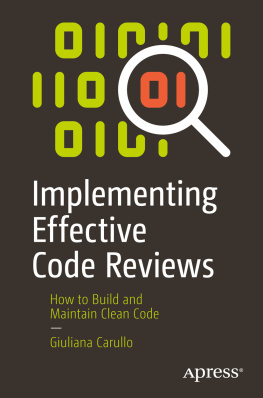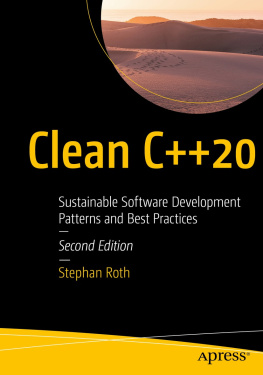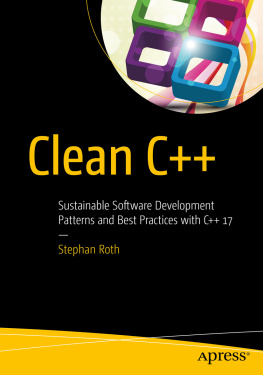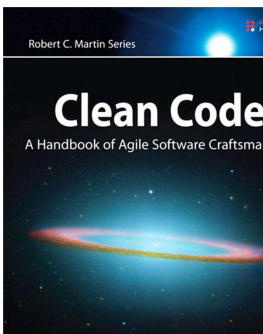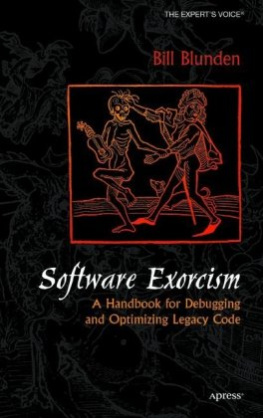
Robert C. Martin Series
The mission of this series is to improve the state of the art of software craftsmanship. The books in this series are technical, pragmatic, and substantial. The authors are highly experienced craftsmen and professionals dedicated to writing about what actually works in practice, as opposed to what might work in theory. You will read about what the author has done, not what he thinks you should do. If the book is about programming, there will be lots of code. If the book is about managing, there will be lots of case studies from real projects.
These are the books that all serious practitioners will have on their bookshelves. These are the books that will be remembered for making a difference and for guiding professionals to become true craftsman.
Managing Agile Projects Sanjiv Augustine
Agile Estimating and Planning Mike Cohn
Working Effectively with Legacy Code Michael C. Feathers
Agile Java: Crafting Code with Test-Driven Development Jeff Langr
Agile Principles, Patterns, and Practices in C# Robert C. Martin and Micah Martin
Agile Software Development: Principles, Patterns, and Practices Robert C. Martin
Clean Code: A Handbook of Agile Software Craftsmanship Robert C. Martin
UML For Java Programmers Robert C. Martin
Fit for Developing Software: Framework for Integrated Tests Rick Mugridge and Ward Cunningham
Agile Software Development with SCRUM Ken Schwaber and Mike Beedle
Extreme Software Engineering: A Hands on Approach Daniel H. Steinberg and Daniel W. Palmer
For more information, visit informit.com/martinseries
Clean Code
A Handbook of Agile Software Craftsmanship
The Object Mentors:
Robert C. Martin
Michael C. Feathers Timothy R. Ottinger
Jeffrey J. Langr Brett L. Schuchert
James W. Grenning Kevin Dean Wampler
Object Mentor Inc.
Writing clean code is what you must do in order to call yourself a professional. There is no reasonable excuse for doing anything less than your best.

Upper Saddle River, NJ Boston Indianapolis San Francisco New York Toronto Montreal London Munich Paris Madrid Capetown Sydney Tokyo Singapore Mexico City
Many of the designations used by manufacturers and sellers to distinguish their products are claimed as trademarks. Where those designations appear in this book, and the publisher was aware of a trademark claim, the designations have been printed with initial capital letters or in all capitals.
The authors and publisher have taken care in the preparation of this book, but make no expressed or implied warranty of any kind and assume no responsibility for errors or omissions. No liability is assumed for incidental or consequential damages in connection with or arising out of the use of the information or programs contained herein.
The publisher offers excellent discounts on this book when ordered in quantity for bulk purchases or special sales, which may include electronic versions and/or custom covers and content particular to your business, training goals, marketing focus, and branding interests. For more information, please contact:
U.S. Corporate and Government Sales
(800) 382-3419
For sales outside the United States please contact:
International Sales
Visit us on the Web: informit.com/ph
Library of Congress Cataloging-in-Publication Data
Martin, Robert C.
Clean code : a handbook of agile software craftsmanship / Robert C. Martin.
p. cm.
Includes bibliographical references and index.
ISBN 0-13-235088-2 (pbk. : alk. paper)
1. Agile software development. 2. Computer softwareReliability. I. Title.
QA76.76.D47M3652 2008
005.1dc22
2008024750
Copyright 2009 Pearson Education, Inc.
All rights reserved. Printed in the United States of America. This publication is protected by copyright, and permission must be obtained from the publisher prior to any prohibited reproduction, storage in a retrieval system, or transmission in any form or by any means, electronic, mechanical, photocopying, recording, or likewise. For information regarding permissions, write to:
Pearson Education, Inc
Rights and Contracts Department
501 Boylston Street, Suite 900
Boston, MA 02116
Fax: (617) 671-3447
ISBN-13: 978-0-13-235088-4
ISBN-10: 0-13-235088-2
Text printed in the United States on recycled paper at Courier in Stoughton, Massachusetts.
Fourth printing February, 2009
For Ann Marie: The ever enduring love of my life.
Contents
Foreword
One of our favorite candies here in Denmark is Ga-Jol, whose strong licorice vapors are a perfect complement to our damp and often chilly weather. Part of the charm of Ga-Jol to us Danes is the wise or witty sayings printed on the flap of every box top. I bought a two-pack of the delicacy this morning and found that it bore this old Danish saw:
rlighed i sm ting er ikke nogen lille ting.
Honesty in small things is not a small thing. It was a good omen consistent with what I already wanted to say here. Small things matter. This is a book about humble concerns whose value is nonetheless far from small.
God is in the details, said the architect Ludwig mies van der Rohe. This quote recalls contemporary arguments about the role of architecture in software development, and particularly in the Agile world. Bob and I occasionally find ourselves passionately engaged in this dialogue. And yes, mies van der Rohe was attentive to utility and to the timeless forms of building that underlie great architecture. On the other hand, he also personally selected every doorknob for every house he designed. Why? Because small things matter.
In our ongoing debate on TDD, Bob and I have discovered that we agree that software architecture has an important place in development, though we likely have different visions of exactly what that means. Such quibbles are relatively unimportant, however, because we can accept for granted that responsible professionals give some time to thinking and planning at the outset of a project. The late-1990s notions of design driven only by the tests and the code are long gone. Yet attentiveness to detail is an even more critical foundation of professionalism than is any grand vision. First, it is through practice in the small that professionals gain proficiency and trust for practice in the large. Second, the smallest bit of sloppy construction, of the door that does not close tightly or the slightly crooked tile on the floor, or even the messy desk, completely dispels the charm of the larger whole. That is what clean code is about.
Still, architecture is just one metaphor for software development, and in particular for that part of software that delivers the initial product in the same sense that an architect delivers a pristine building. In these days of Scrum and Agile, the focus is on quickly bringing product to market. We want the factory running at top speed to produce software. These are human factories: thinking, feeling coders who are working from a product backlog or user story to create product. The manufacturing metaphor looms ever strong in such thinking. The production aspects of Japanese auto manufacturing, of an assembly-line world, inspire much of Scrum.
Next page


